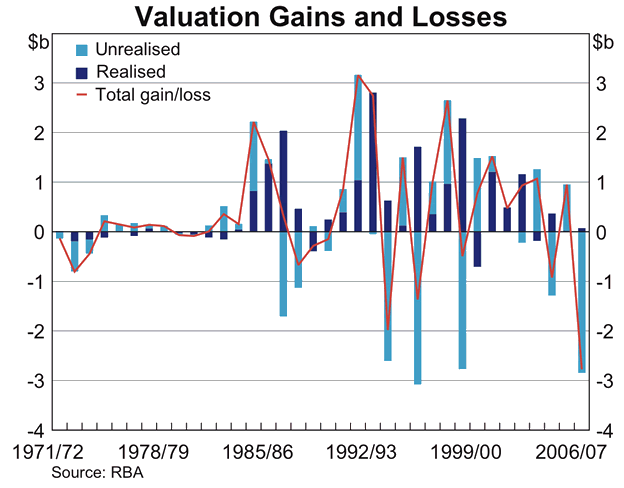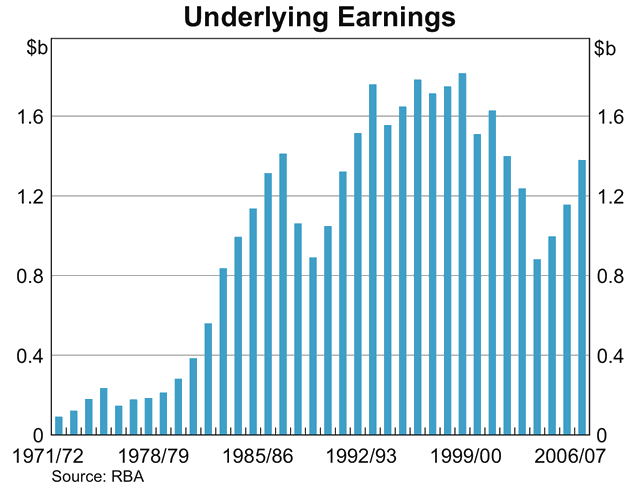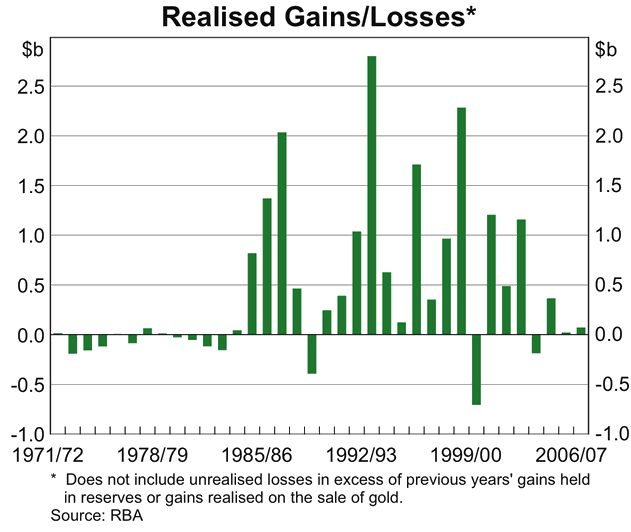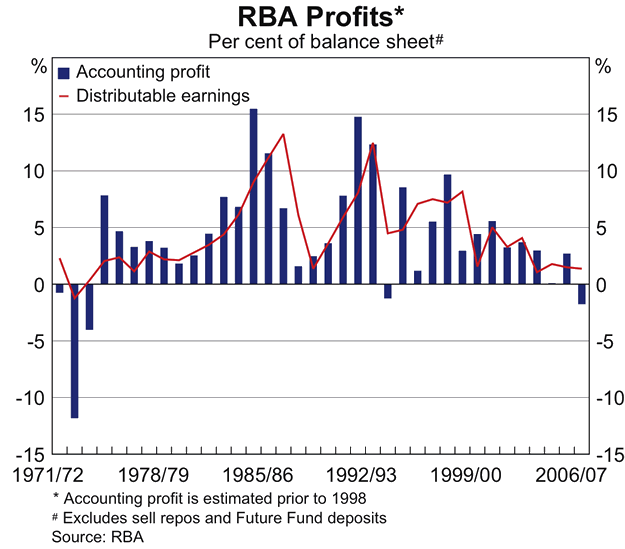Reserve Bank of Australia Annual Report – 2007 Earnings and Distribution
The Reserve Bank's balance sheet in important respects is like that of other financial institutions. The Bank holds financial assets, on which it earns interest, funded by capital, deposits and other liabilities. The composition of this balance sheet differs from that of a commercial bank, however, because while banks typically hold a high proportion of loans to the private sector, the assets of central banks are more usually in the form of highly rated, government-issued domestic and foreign securities. This means that the composition of the risks faced by central banks differs from that faced by other financial institutions. Central banks primarily have exposure to market risks, rather than the credit risks typically faced by commercial banks. Although the securities held by central banks generate a stream of interest payments, measured income is also affected, often significantly, by valuation gains (or losses) that reflect movements in the prices of the assets held: as security yields rise the price of these securities falls, while a fall in yields leads to higher prices. Valuation losses also occur on foreign assets when the exchange rate appreciates, as these assets are then worth less when measured in Australian dollars; foreign exchange valuation gains occur when the exchange rate depreciates.
Reflecting these characteristics, earnings of the Reserve Bank are typically viewed as having two components. The first of these is underlying earnings – the net interest earned on financial assets less the Bank's operating and other non‑interest costs. Underlying earnings are relatively stable and usually substantial, since a large proportion of the Bank's assets is funded by banknotes and its capital and reserves, on which no interest is payable, while almost all of its assets earn interest. The second component of profit is valuation gains and losses that arise from movements in the value of assets. Valuation gains or losses are realised only when assets are sold; they otherwise remain unrealised.
The Reserve Bank differs from other financial institutions in another important respect, since it holds financial assets and liabilities for policy purposes, not primarily for gain. This means that the Bank's discretion to manage market risk on these assets is limited. As movements in interest and exchange rates can be volatile, valuation gains and losses are also highly variable and unpredictable. (The underlying issues and longer-term trends in Reserve Bank profits were discussed in the chapter on The Variability of Reserve Bank Profits in the 2003 Annual Report. ) More to the point, because it must hold large open positions in foreign exchange and a liquid portfolio of securities, the Bank will inevitably make valuation losses in years in which the exchange rate appreciates or bond yields rise, or, as in 2006/07, both occur. Valuation losses have been a particularly important influence on the Reserve Bank's earnings in the past year as the exchange rate appreciated by 12 per cent in weighted-average terms against the currencies in which Australia's international reserves are invested. Bond yields also rose around the world.

For reporting purposes, the recognition and measurement of the Reserve Bank's profit and loss follow in all respects normal commercial standards under Australian equivalents to International Financial Reporting Standards (AIFRS). Distribution of these earnings is, however, determined by section 30 of the Reserve Bank Act 1959. This legislation determines that only underlying earnings and realised gains are to be made available for distribution. The sum of these components is usually referred to as earnings available for distribution, or distributable earnings. On the other hand, unrealised gains are transferred to the Unrealised Profits Reserve until realised at a future time, or to remain available to absorb future unrealised losses. This approach to distribution of the Reserve Bank's profits, as embedded in the Act, reflects prudent central banking practice. It recognises the principle that unrealised gains should not be distributed, as this would erode the capacity to absorb subsequent unrealised losses, which, for the reasons discussed, are inevitable in some years.
Experience is that transfers of gains to the Unrealised Profits Reserve occur about as frequently as transfers of unrealised losses. Moreover, as valuation gains and losses are of moderate size in most years, the balance in the Unrealised Profits Reserve is usually large enough to absorb valuation losses, thereby cushioning the impact on the dividend payment of the adverse effects of a rise in the exchange rate or bond yields. If, however, unrealised losses exceed the balance in this reserve, sound practice is for the difference to be charged against income from other sources, namely from underlying earnings and realised gains. In 2006/07, unrealised valuation losses amounted to $2,846 million, which exceeded by $371 million the balance in the Unrealised Profits Reserve at the start of the year. This has the effect of reducing earnings available for distribution by this amount.
Distributable Earnings
The Reserve Bank's underlying earnings in 2006/07 were $1,381 million, compared with $1,156 million the previous year. This increase reflects the global rise in interest rates, which continued the trend of recent years, following a period in which rates had declined to unusually low levels.

Gains of $75 million were realised on the portfolio in 2006/07, compared with $21 million the previous year. Foreign exchange gains of $205 million were realised as foreign exchange was sold in daily operations for customers and to manage foreign currency reserves at exchange rates below those at which the foreign exchange was purchased. These gains were offset by losses of $122 million and $11 million realised on foreign and domestic securities respectively, as interest rates rose during 2006/07 and lines of stock were turned over in the normal course of managing these portfolios.

In addition, as noted, an amount of $371 million was charged against these other sources of income in 2006/07, the sum by which unrealised losses on foreign exchange and securities exceeded the balance of unrealised gains held in the Unrealised Profits Reserve. This approach is consistent with accounting principles and section 30 of the Reserve Bank Act 1959, i.e. unrealised valuation losses reduce the amount available for distribution unless there are reserves built up from earlier unrealised gains that are sufficient to absorb the unrealised losses. Such a charge against other sources of income has previously occurred in five of the past 20 years, the most recent being in 1998/99.
| Underlying earnings |
Realised gains and losses |
Unrealised losses charged to other sources of income |
Earnings available for distribution |
|
|---|---|---|---|---|
| 1986/87 | 1,412 | 2,035 | – | 3,447 |
| 1987/88 | 1,062 | 464 | – | 1,526 |
| 1988/89 | 891 | −394 | −80 | 417 |
| 1989/90 | 1,049 | 245 | −199 | 1,095 |
| 1990/91 | 1,322 | 391 | – | 1,713 |
| 1991/92 | 1,516 | 1,038 | – | 2,554 |
| 1992/93 | 1,760 | 2,803 | – | 4,563 |
| 1993/94 | 1,556 | 628 | −676 | 1,508 |
| 1994/95 | 1,649 | 123 | – | 1,772 |
| 1995/96 | 1,784 | 1,712 | −1,010 | 2,486 |
| 1996/97 | 1,715 | 1,990 | – | 3,705 |
| 1997/98 | 1,750 | 1,524 | – | 3,274 |
| 1998/99 | 1,816 | 2,284 | −424 | 3,676 |
| 1999/00 | 1,511 | −708 | – | 803 |
| 2000/01 | 1,629 | 1,205 | – | 2,834 |
| 2001/02 | 1,400 | 489 | – | 1,889 |
| 2002/03 | 1,238 | 1,159 | – | 2,397 |
| 2003/04 | 882 | −188 | – | 694 |
| 2004/05 | 997 | 366 | – | 1,363 |
| 2005/06 | 1,156 | 21 | – | 1,177 |
| 2006/07 | 1,381 | 75 | −371 | 1,085 |
Earnings available for distribution – the sum of underlying earnings and realised gains less the charge for ‘excess’ unrealised losses – amounted to $1,085 million in 2006/07, compared with $1,177 million distributed from profits the previous year.
Reserves and Dividend
The Reserve Bank maintains a general reserve, the Reserve Bank Reserve Fund (RBRF), to provide for events that are contingent and non-foreseeable, including covering losses from exceptionally large falls in the market value of its holdings of domestic and foreign securities that could not be absorbed by other resources. This reserve also provides for the range of other risks to which the Bank is exposed, including fraud and operational risks. The RBRF has been funded over the years by transfers from earnings available for distribution and is, in all respects, essentially capital.
In accordance with the Reserve Bank Act 1959, after consultation with the Reserve Bank Board, the Treasurer determines the amount, if any, to be credited to the RBRF from earnings available for distribution. The balance of distributable earnings after any such transfers is payable as a dividend to the Australian Government. As the Board regards the balance of $6,286 million in the RBRF at 30 June 2007 as satisfactory, it did not approach the Treasurer for a transfer from profits in 2006/07. Consequently, all of the earnings available for distribution in 2006/07, a sum of $1,085 million, was paid as a dividend to the Australian Government in August 2007.
The Reserve Bank also maintains a number of other financial reserves. As outlined earlier, under the Reserve Bank Act 1959 unrealised gains are not available to be distributed but are transferred to the Unrealised Profits Reserve. That reserve started the year with an accumulated balance of $2,476 million, but this was more than absorbed by the unrealised valuation losses of $2,846 million made during the year. At 30 June 2007, the balance in the Unrealised Profits Reserve was nil, after transferring the charge against profit.
The Reserve Bank also holds asset revaluation reserves for its gold holdings, shares in the BIS, and property, plant and equipment. The balances in these reserves represent the difference between the market value of these assets and the prices at which they were purchased. Balances in these reserves at 30 June 2007 stood at $2,239 million, a decrease of $115 million from a year ago, mainly reflecting a decrease in the Australian dollar value of the Bank's holding of gold. Balances in these reserves are distributed only in the event that the underlying assets are sold. On that score, gains of $3 million were realised from the sale of overseas properties in 2006/07; this amount has been included as a realised gain and will be distributed as earnings.
Accounting Profits
As the Reserve Bank reports under AIFRS, in accordance with the Commonwealth Authorities and Companies Act 1997, total accounting profits include revenue from all sources, including valuation gains and losses, both realised and unrealised. After allowing for net unrealised valuation losses of $2,475 million, the Bank recorded a total accounting loss of $1,393 million. The Bank has reported on the basis of generally accepted accounting principles or AIFRS since 1998. If the Bank had reported on the same basis as it currently does in earlier periods, it would have disclosed accounting losses on four previous occasions since 1970, the latest being in 1993/94.
| Earnings available for distribution | Transfers to reserves |
Payments to the Australian Government | Total payment | ||||
|---|---|---|---|---|---|---|---|
| Balance available from current year's profit |
Interim payment from current year's profit |
Payment from previous year's profit | Payment delayed from previous years | ||||
| 1990/91 | 1,713 | 210 | 1,503 | 400 | 275 | – | 675 |
| 1991/92 | 2,554 | 200 | 2,354 | 400 | 1,103 | – | 1,503 |
| 1992/93 | 4,563 | 750 | 3,813 | 600 | 1,954 | – | 2,554 |
| 1993/94 | 1,508 | – | 1,508 | – | 3,213 | – | 3,213 |
| 1994/95 | 1,772 | – | 1,772 | 200 | 1,508 | – | 1,708 |
| 1995/96 | 2,486 | 150 | 2,336 | 200 | 1,572 | – | 1,772 |
| 1996/97 | 3,705 | 2,005 | 1,700 | – | 2,136 | – | 2,136 |
| 1997/98 | 3,274 | 548 | 2,726 | – | 1,700 | – | 1,700 |
| 1998/99 | 3,676 | – | 3,676 | – | 2,726 | – | 2,726 |
| 1999/00 | 803 | – | 803 | – | 3,000 | – | 3,000 |
| 2000/01 | 2,834 | – | 2,834 | – | 803 | 676 | 1,479 |
| 2001/02 | 1,889 | – | 1,889 | – | 2,834 | – | 2,834 |
| 2002/03 | 2,397 | 133 | 2,264 | – | 1,889 | – | 1,889 |
| 2003/04 | 694 | – | 694 | – | 1,300 | – | 1,300 |
| 2004/05 | 1,363 | – | 1,363 | – | 374 | 964 | 1,338 |
| 2005/06 | 1,177 | – | 1,177 | – | 1,063 | 320 | 1,383 |
| 2006/07 | 1,085 | – | 1,085 | – | 1,177 | 300 | 1,477 |
| 2007/08 | – | – | – | – | 1,085 | – | 1,085 |

The Reserve Bank's Financial Statements for 2006/07, and accompanying Notes to the Accounts, appear in the following pages.